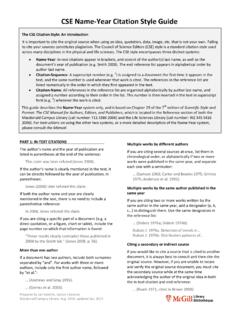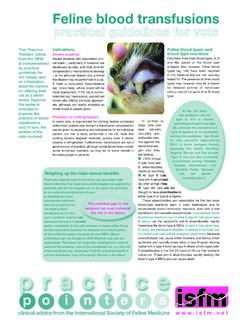Transcription of Cardiovascular Pharmacology - McGill University
1 118 Chapter 8 Cardiovascular PharmacologyRoger L. Royster, MD John F. Butterworth IV, MD Leanne Groban, MD Thomas F. Slaughter, MD David A. Zvara, MDAnti-ischemic Drug therApyAnti-ischemic drug therapy during anesthesia is indicated whenever evidence of myocardial ischemia exists. The treatment of ischemia during anesthesia is compli-cated by the ongoing stress of surgery, blood loss, concurrent organ ischemia, and the patient s inability to interact with the anesthesiologist. Nonetheless, the fundamental principles of treatment remain the same as in the unanesthetized state. All events of myocardial ischemia involve an alteration in the oxygen supply/demand balance (Table 8-1).
2 The 2007 American College of Cardiology/American Heart Association (ACC/AHA) Guidelines on the Management and Treatment of Patients with Unstable Angina and Non ST-Segment Elevation Myocardial Infarction provide an excellent framework for the treatment of patients with ongoing myocardial (NTG) is clinically indicated as initial therapy in nearly all types of myocardial ischemia. Chronic exertional angina, de novo angina, unstable angina, Prinzmetal s angina (vasospasm), and silent ischemia respond to NTG Anti-Ischemic Drug TherapyNitroglycerin -Adrenergic BlockersCalcium Channel BlockersDrug Therapy for Systemic HypertensionMedical Treatment for HypertensionManagement of Severe HypertensionPharmacotherapy for Acute and Chronic Heart FailureHeart Failure ClassificationPathophysiologic Role of the Renin- Angiotensin System in Heart Failure -Adrenergic Receptor AntagonistsAdjunctive DrugsFuture TherapyManagement of Acute Exacerbations of Chronic Heart FailureLow-Output SyndromePharmacologic Treatment of Diastolic Heart FailureCurrent Clinical PracticePharmacotherapy for Cardiac ArrhythmiasClass I
3 Antiarrhythmic Drugs: Sodium Channel BlockersClass II: -Adrenergic Receptor AntagonistsClass III: Agents That Block Potassium Channels and Prolong RepolarizationClass IV: Calcium Channel AntagonistsOther Antiarrhythmic AgentsSummaryAnti-Ischemic Drug TherapyDrug Therapy for Systemic HypertensionPharmacotherapy for Acute and Chronic Heart FailurePharmacotherapy for Cardiac ArrhythmiasReferences8 Cardiovascular PHARMACOLOGY119administration. During intravenous therapy with NTG, if blood pressure (BP) drops and ischemia is not relieved, the addition of phenylephrine will allow coronary perfusion pressure (CPP) to be maintained while allowing higher doses of NTG to be used for ischemia relief.
4 If reflex increases in heart rate (HR) and contractility occur, combination therapy with -adrenergic blockers may be indicated to blunt this undesired increase in HR. Combination therapy with nitrates and calcium chan-nel blockers may be an effective anti-ischemic regimen in selected patients; however, excessive hypotension and reflex tachycardia may be a problem, especially when a dihydropyridine calcium antagonist is of ActionNTG enhances myocardial oxygen delivery and reduces myocardial oxygen demand. NTG is a smooth muscle relaxant that causes vasculature Nitrate-mediated vasodilation occurs with or without intact vascular endothelium.
5 Nitrites, organic nitrites, nitroso compounds, and other nitrogen oxide containing substances ( , nitroprusside) enter the smooth muscle cell and are converted to reactive nitric oxide (NO) or S-nitrosothiols, which stimulate guanylate cyclase metabolism to pro-duce cyclic guanosine monophosphate (cGMP) (Fig. 8-1). A cGMP-dependent pro-tein kinase is stimulated with resultant protein phosphorylation in the smooth muscle. This leads to a dephosphorylation of the myosin light chain and smooth muscle relaxation. Vasodilation is also associated with a reduction of intracellular calcium. Sulfhydryl (SH) groups are required for formation of NO and the stimulation of gua-nylate cyclase.
6 When excessive amounts of SH groups are metabolized by prolonged exposure to NTG, vascular tolerance occurs. The addition of N-acetylcysteine, an SH donor, reverses NTG tolerance. The mechanism by which NTG compounds are uniquely better venodilators, especially at lower serum concentrations, is unknown but may be related to increased uptake of NTG by veins compared with EffectsTwo important physiologic effects of NTG are systemic and regional venous dilation. Venodilation can markedly reduce venous pressure, venous return to the heart, and cardiac filling pressures. Prominent venodilation occurs at lower doses and does not increase further as the NTG dose increases.
7 Venodilation results primarily in pooling O2 SupplyO2 DemandHeart rate*Heart rate*O2 contentContractilityHemoglobin, percent oxygen saturation, Pao2 Wall tensionCoronary blood flowAfterloadCPP = DBP LVEDP*Preload (LVEDP)*Coronary vascular resistance CPP = coronary perfusion pressure; DBP = diastolic blood pressure; LVEDP = left ventricular end diastolic pressure.*Affects both supply and from Royster RL: Intraoperative administration of inotropes in cardiac surgery patients. J Cardiothorac Anesth 6(Suppl 5):17, 8 1 Myocardial Ischemia: Factors Governing O2 Supply and DemandIICARDIOVASCULAR PHYSIOLOGY, Pharmacology , AND MOLECULAR BIOLOGY120of blood in the splanchnic capacitance system.
8 Mesenteric blood volume increases as ventricular size, ventricular pressures, and intrapericardial pressure increases the distensibility and conductance of large arteries without chang-ing systemic vascular resistance (SVR) at low doses. Improved compliance of the large arteries does not necessarily imply afterload reduction. At higher doses, NTG dilates smaller arterioles and resistance vessels, which reduces afterload and BP. Reductions in cardiac dimension and pressure reduce myocardial oxygen consump-tion (M o2) and improve myocardial ischemia. NTG may preferentially reduce cardiac preload while maintaining systemic perfusion pressure, an important hemo-dynamic effect in myocardial ischemia.
9 However, in hypovolemic states, higher doses of NTG may markedly reduce systemic BP to dangerous levels. A reflex increase in HR may occur at arterial vasodilating causes vasodilation of pulmonary arteries and veins and predictably decreases right atrial (RAP), pulmonary artery (PAP), and pulmonary capillary wedge pres-sures (PCWP). Pulmonary artery hypertension may be reduced in various disease states and in congenital heart disease with has several important effects on the coronary circulation (Box 8-1). NTG is a potent epicardial coronary artery vasodilator in both normal and diseased ves-sels. Stenotic lesions dilate with NTG, reducing the resistance to coronary blood flow (CBF) and improving myocardial ischemia.
10 Smaller coronary arteries may dilate relatively more than larger coronary vessels; however, the degree of dilation may depend on the baseline tone of the vessel. NTG effectively reverses or prevents coro-nary artery CBF may initially increase but eventually decreases with NTG despite coronary vasodilation. Autoregulatory mechanisms probably result in decreases in total flow as a result of reductions in wall tension and myocardial oxygen consump-tion. However, regional myocardial blood flow may improve by vasodilation of intercoronary collateral vessels or reduction of subendocardial compressive forces. +NitroglycerinMononitrateR-ONO2 EndoOpie (1997)ONO2 ONO2 ONO2 PhysiologicdilatorsLIVERC ytoplasmGTPVaso-dilationNitrate nitratesdeplete-SH?












